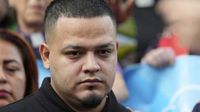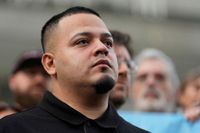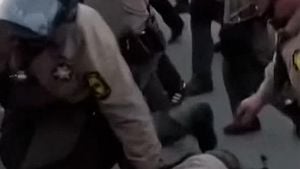Kilmar Abrego Garcia’s name has become synonymous with the fierce legal and political battles now raging over U.S. immigration policy. Once a construction worker living quietly in Maryland with his wife and children, Abrego Garcia now sits in a Virginia detention center, his fate suspended between continents and courtrooms. His story, tangled with allegations, legal reversals, and international intrigue, is unfolding under the watchful eye of U.S. District Judge Paula Xinis, who has temporarily blocked the Trump administration from deporting him—at least until an evidentiary hearing scheduled for October 6, 2025.
The case is as complex as it is consequential. According to ABC News, Judge Xinis extended her restraining order on August 27, 2025, preventing Abrego Garcia’s removal until his court challenge is resolved. She made it clear: “I will issue a ruling within 30 days of the October 6 hearing.” For now, Abrego Garcia must remain in custody within a 200-mile radius of the Maryland court, currently held at a facility in Farmville, Virginia. Judge Xinis declined to order his release, pointing out that such a decision should be left to an immigration judge.
Abrego Garcia’s legal team is fighting on multiple fronts. On August 25, his attorneys filed an emergency motion to reopen his immigration case and apply for asylum. Their argument hinges on a technicality: because Abrego Garcia was deported and then brought back to the U.S. in June 2025, he is now eligible to apply for asylum within a year of his most recent entry. They also requested that, if deportation is inevitable, Costa Rica should be designated as his country of removal—an option federal law allows under specific conditions.
The backstory reads like something out of a legal thriller. Abrego Garcia, a native of El Salvador, fled his homeland around 2011 at age 16, escaping gang extortion and violence, according to AP reports. He settled in Maryland, found work, got married, and started a family. But in 2019, a routine day labor pickup outside a Home Depot became a turning point. Local police, acting on a tip that men outside the store could be MS-13 gang members based on their clothing and tattoos, detained Abrego Garcia. He was never charged with any crime, and he has consistently denied any gang affiliation. Nevertheless, he was handed over to Immigration and Customs Enforcement (ICE) and applied for asylum.
That initial asylum request was denied—not on the merits, but because it was filed more than a year after his arrival in the U.S. However, an immigration judge did issue a 2019 order shielding him from deportation to El Salvador, recognizing his credible fear of gang persecution. Under federal supervision, Abrego Garcia continued to live with his family, checked in with ICE annually, and worked as a sheet metal apprentice.
Then, in March 2025, the Trump administration deported him to El Salvador’s infamous CECOT mega-prison, in direct violation of the 2019 court order. The administration insisted he was an MS-13 member—a claim his family and attorneys vehemently deny. Mounting pressure, a lawsuit from his wife, and a U.S. Supreme Court order eventually forced his return to the U.S. in June. But freedom was fleeting. He was brought back to face human smuggling charges in Tennessee, stemming from a 2022 traffic stop where he was found with nine passengers and $1,400 in cash. Abrego Garcia pleaded not guilty, arguing the charges were retaliation for his legal challenges against deportation.
After his release from jail on August 22, 2025, Abrego Garcia checked in with ICE in Baltimore as required—only to be detained again and told he would be deported, this time to Uganda. This abrupt shift caught many off guard. Uganda, a country where Abrego Garcia has no known ties, suddenly became the administration’s designated destination for his removal. His attorneys quickly moved to block the deportation, and Judge Xinis stepped in with her restraining order.
Why Uganda? According to The Hill, the Trump administration’s move may have been triggered by Abrego Garcia’s refusal to accept a plea deal in his criminal case. The deal, offered just before his release, would have sent him to Costa Rica—his preferred country of removal—if he agreed to plead guilty and serve prison time. When he declined, the administration pivoted to Uganda. Judge Xinis expressed concern, stating, “You can’t condition the relinquishing of a constitutional right in that regard.” She suggested that the government’s actions might violate federal law, which allows noncitizens to designate their country of removal, barring certain exceptions.
Costa Rica, for its part, has indicated a willingness to accept Abrego Garcia as a lawful immigrant and pledged not to send him back to El Salvador. In contrast, Uganda has remained silent on whether it would offer him any protections. Judge Xinis noted, “The silence is taken certainly in contrast to what’s been provided by the country of Costa Rica. The contrast is significant.”
Abrego Garcia’s fears about Uganda are not abstract. On August 23, he signed a notice expressing fear of persecution, torture, and the risk of being sent back to El Salvador if deported to Uganda. His lawyer, Simon Sandoval-Moshenberg, told reporters, “To me, it seems very clear—crystal clear—that while we’re waiting for that interview to be scheduled, while we’re waiting for the results of that interview, they can’t put him on a plane.” Under federal law, he is entitled to a “reasonable fear interview” before any removal to Uganda can proceed.
The broader implications of the case are hard to ignore. Immigration courts, now under the Trump administration’s authority, have become a focal point for the president’s renewed enforcement push. According to AP, more than 50 immigration judges have been fired since Trump’s return to the White House in January. As Ohio State University law professor César Cuauhtémoc García Hernández put it, “I wish I could tell you that I am 100% confident that they’re not going to stick him on an airplane to Kampala right now. But I can’t because the president is personally involved in his legal fight. The attorney general is personally involved in his legal fight... Half the Cabinet officials know who he is.”
Judge Xinis, for her part, has been careful to clarify her role. She told lawyers, “We have the understanding that the asylum process is of no moment to me. I don’t have jurisdiction over that.” Her focus is on ensuring Abrego Garcia’s right to due process—not on deciding his asylum claim or final destination. She is set to rule on whether the administration’s actions have violated his legal rights, especially regarding his ability to designate Costa Rica as his country of removal and to seek protection from deportation to a place where he fears for his life.
As the October hearing approaches, Abrego Garcia’s case continues to draw attention from legal experts, immigrant advocates, and government officials alike. The outcome could set significant precedents for how the U.S. handles contested deportations, the rights of asylum seekers, and the limits of executive power over immigration policy. For now, one man’s fight to avoid a perilous journey to Uganda remains at the center of a much larger national debate.





